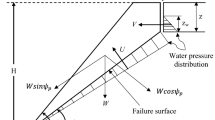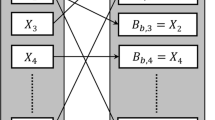Abstract
The reliability-based robust geotechnical design (RGD) approach provides an effective tool to deal with the uncertainty in the estimated statistics of geotechnical parameters in a reliability-based design. However, the existing reliability-based RGD approach is not straightforward to apply as it involves multiple concepts. In this paper, the applicability of the existing reliability-based RGD approach is improved by utilizing Monte Carlo simulation (MCS). Here, an MCS-based weighted technique is used to evaluate the failure probability of a geotechnical system. With the aid of this weighted technique, the variation in the failure probability, caused by the uncertainty in the estimated statistics of geotechnical parameters, is computed using MCS. To further improve the efficiency of the RGD method, a series of single-objective optimizations are used in lieu of a multi-objective optimization in the robust design optimization process. The proposed MCS-based RGD approach is illustrated through an example of rock slope design. Compared with the existing reliability-based RGD approach, the MCS-based RGD approach is not only more intuitive and easier to follow, but also more computationally efficient.










Similar content being viewed by others
References
Ang HS, Tang WH (2007) Probability concepts in engineering: emphasis on applications to civil and environmental engineering, 2nd edn. Wiley, New York
Baecher GB, Christian JT (2003) Reliability and statistics in geotechnical engineering. Wiley, New Jersey
Beckman RJ, McKay MD (1987) Monte Carlo estimation under different distributions using the same simulation. Technometrics 29(2):153–160
Cao ZJ, Wang Y, Li DQ (2016) Quantification of prior knowledge in geotechnical site characterization. Eng Geol 203:107–116
Deb K, Pratap A, Agarwal S, Meyarivan TAMT (2002) A fast and elitist multiobjective genetic algorithm: NSGA-II. Evol Comput, IEEE Trans on 6(2):182–197
El-Ramly H, Morgenstern NR, Cruden DM (2002) Probabilistic slope stability analysis for practice. Can Geotech J 39(3):665–683
Fenton GA, Griffiths DV (2008) Risk assessment in geotechnical engineering. Wiley, New York
Fenton GA, Griffiths DV, Williams MB (2005) Reliability of traditional retaining wall design. Geotechnique 55(1):55–62
Fonseca JR, Friswell MI, Lees AW (2007) Efficient robust design via Monte Carlo sample reweighting. Int J Numer Method Eng 69(11):2279–2301
Ghosh A, Dehuri S (2004) Evolutionary algorithms for multi-criterion optimization: a survey. Int J Comput Inf Sci 2(1):38–57
Gong W, Tien YM, Juang CH, Martin JR, Zhang J (2016) Calibration of empirical models considering model fidelity and model robustness—Focusing on predictions of liquefaction-induced settlements. Eng Geol 203:168–177
Harr ME (1987) Reliability-based design in civil engineering. McGraw-Hill, New York
Hoek E (2006) Practical rock engineering. Chapter 7: a slope stability problem in Hong Kong; and chapter 8: factor or safety and probability of failure. (In: http://www.rocscience.com/hoek/PracticalRockEngineering.asp)
Hoek E, Bray J (1981) Rock Slope Engineering, 3rd edn. Institution of mining and metallurgy, London
Jamshidi Chenari R, Alaie R (2015) Effects of anisotropy in correlation structure on the stability of an undrained clay slope. Georisk 9(2):109–123
Jiang SH, Li DQ, Zhang LM, Zhou CB (2014) Slope reliability analysis considering spatially variable shear strength parameters using a non-intrusive stochastic finite element method. Eng Geol 168:120–168
Jiang SH, Li DQ, Cao ZJ, Zhou CB, Phoon KK (2015) Efficient system reliability analysis of slope stability in spatially variable soils using Monte Carlo simulation. J Geotech Geoenviron Eng 141(2):04014096
Juang CH, Wang L (2013) Reliability-based robust geotechnical design of spread foundations using multi-objective genetic algorithm. Comput Geotech 48:96–106
Juang CH, Wang L, Atamturktur S, Luo Z (2012) Reliability-based robust and optimal design of shallow foundations in cohesionless soil in the face of uncertainty. J Geoengin 7(3):75–87
Juang CH, Wang L, Khoshnevisan S, Atamturktur S (2013a) Robust geotechnical design: Methodology and applications. J Geoengin 8(3):61–70
Juang CH, Wang L, Liu ZF, Ravichandran N, Huang HW, Zhang J (2013b) Robust geotechnical design of drilled shafts in sand: new design perspective. J Geotech Geoenviron Eng 139(12):2007–2019
Khoshnevisan S, Gong WP, Wang L, Juang CH (2014) Robust design in geotechnical engineering—an update. Georisk 8(4):217–234
Khoshnevisan S, Gong W, Juang CH, Atamturktur S (2015) Efficient robust geotechnical design of drilled shafts in clay using a spreadsheet. J Geotech Geoenviron Eng 141(2):04014092
Khoshnevisan S, Wang L, Juang CH (2016) Simplified procedure for reliability-based robust geotechnical design of drilled shafts in clay using spreadsheet. Georisk 10(2):121–134
Lee YF, Chi YY, Juang CH, Lee DH (2011) Reliability analysis of rock wedge stability: knowledge-based clustered partitioning approach. J Geotech Geoenviron Eng 138(6):700–708
Li DQ, Chen YF, Lu WB, Zhou CB (2011) Stochastic response surface method for reliability analysis of rock slopes involving correlated non-normal variables. Comput Geotech 38(1):58–68
Li DQ, Zhang FP, Cao ZJ, Zhou W, Phoon KK, Zhou CB (2015) Efficient reliability updating of slope stability by reweighting failure samples generated by Monte Carlo simulation. Comput Geotech 69:588–600
Li DQ, Qi XH, Cao ZJ, Tang XS, Phoon KK, Zhou CB (2016a) Evaluating slope stability uncertainty using coupled Markov chain. Comput Geotech 73:72–82
Li DQ, Shao KB, Cao ZJ, Tang XS, Phoon KK (2016b) A generalized surrogate response aided-subset simulation approach for efficient geotechnical reliability-based design. Comput Geotech 74:88–101
Li DQ, Zheng D, Cao ZJ, Tang XS, Phoon KK (2016c) Response surface methods for slope reliability analysis: a review and comparison. Eng Geol 203:3–14
Low BK (2007) Reliability analysis of rock slopes involving correlated nonnormals. Int J Rock Mech Min Sci 44(6):922–935
Low BK (2008) Efficient probabilistic algorithm illustrated for a rock slope. Rock Mech Rock Eng 41(5):715–734
Low BK, Tang WH (1997) Reliability analysis of reinforced embankments on soft ground. Can Geotech J 34(5):672–685
Macciotta R, Parkinson G, Garcia E, Bravo O (2015) Managing uncertainty in underground excavation design associated with rock mass characterization using core drilled for mineral exploration. Bull Eng Geol Environ 74(4):1419–1434
Phoon KK, Ching J (2014) Risk and reliability in geotechnical engineering. CRC, New York
Phoon KK, Kulhawy FH (1999) Characterization of geotechnical variability. Can Geotech J 36(4):612–624
Tang XS, Li DQ, Zhou CB, Phoon KK (2015) Copula-based approaches for evaluating slope reliability under incomplete probability information. Struct Saf 52:90–99
Wang Y (2013) MCS-based probabilistic design of embedded sheet pile walls. Georisk 7(3):151–162
Wang Y, Au SK, Kulhawy FH (2011) Expanded reliability-based design approach for drilled shafts. J Geotech Geoenviron Eng 137(2):140–149
Wang L, Hwang JH, Juang CH, Atamturktur S (2013) Reliability-based design of rock slopes—a new perspective on design robustness. Eng Geol 154:56–63
Wang XG, Jia ZX, Chen ZY, Xu Y (2016) Determination of discontinuity persistent ratio by Monte-Carlo simulation and dynamic programming. Eng Geol 203:83–98
Yuan XK (2013) Local estimation of failure probability function by weighted approach. Probab Eng Mech 34:1–11
Zhao YG, Ono T (2000) New point estimates for probability moments. J Eng Mech 126(4):433–436
Acknowledgments
This work was supported in part by the National Science Foundation through Grant CMMI-1200117 (“Transforming Robust Design Concept into a Novel Geotechnical Design Tool”). The results and opinions expressed in this paper do not necessarily reflect the views and policies of the National Science Foundation. This work was also supported by the National Science Fund for Distinguished Young Scholars (Project No. 51225903), the National Natural Science Foundation of China (Project Nos. 51329901, 51579190, 51528901), and the Natural Science Foundation of Hubei Province of China (Project No. 2014CFA001). The first author also wishes to thank Clemson University for hosting his 2-year visit as an exchange student.
Author information
Authors and Affiliations
Corresponding author
Appendix: Solution model for rock slope stability analysis
Appendix: Solution model for rock slope stability analysis
In reference to Fig. 4, the factor of safety (FS) for the rock slope is expressed as the ratio of the sum of all resisting forces to the sum of all driving forces (Hoek and Bray 1981; Hoek 2006):
where c is the cohesive strength along the sliding surface, A is the base area of the wedge, W is the weight of rock wedge resting on the failure surface, ψ p is the angle of failure surface measured from the horizontal plane, α is the gravitational acceleration coefficient defined by the ratio of horizontal to the gravitational acceleration, U is the uplift force due to the water pressure on the failure surface, V is the horizontal force due to the water in the tension crack, and φ is the friction angle of the sliding surface.
The following intermediate terms for computing FS are obtained from the basic slope geometry and rock properties (Hoek 2006):
where H is the height of the overall slope, z is the depth of tension crack, z w is the depth of the water in the tension crack, ψ f is the overall slope angle measured from the horizontal, and i w is the percentage of the tension crack depth filled with water.
Based on Eq. (9), the corresponding performance function can be expressed as:
Rights and permissions
About this article
Cite this article
Peng, X., Li, DQ., Cao, ZJ. et al. Reliability-based robust geotechnical design using Monte Carlo simulation. Bull Eng Geol Environ 76, 1217–1227 (2017). https://doi.org/10.1007/s10064-016-0905-3
Received:
Accepted:
Published:
Issue Date:
DOI: https://doi.org/10.1007/s10064-016-0905-3




